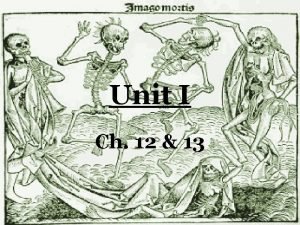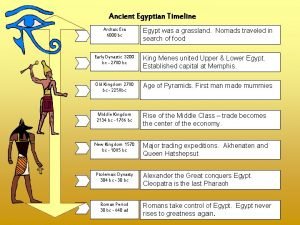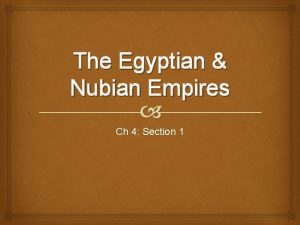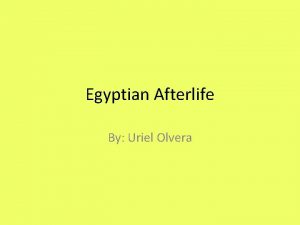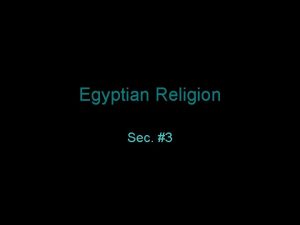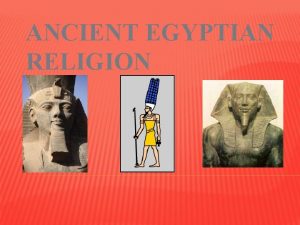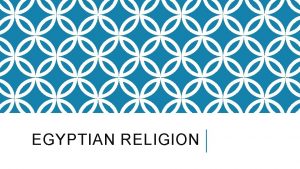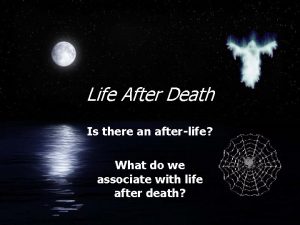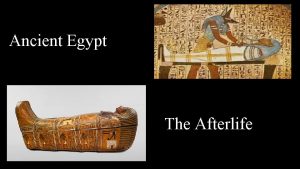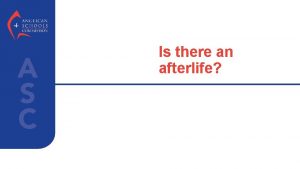Section 3 Egyptian Religion Afterlife life after death










- Slides: 10

Section 3: Egyptian Religion • Afterlife- life after death • Religion was important to the daily life of Egyptians. • Gods and goddesses controlled the workings of nature. • They built temples to honor the gods.

Regional Differences • Early on, Egyptian towns had own gods and goddesses with own temples. • Often shown as humans with animal heads. • Also worshipped a principle god, such as the sun god Re and the falcon god Horus. • Over time believed in several groups of gods.

Important Gods • Chief God- Amon- Re- Protected the rich and the poor alike, he was born each morning in the east with the sunrise and died with the sunset in the west. • That is why the desert area to the west was believed to be the home of the dead. • Osiris- God of living and dead. • Isis- wife of Osiris, great mother who protected her children. • Horus, sky god, was their son.

Belief in the Afterlife • Spirits of the dead made their way to the afterlife in heavenly boats. • If they pleased the gods of the world they joined Osiris and lived a life of pleasure where they spend their days visiting with family and friends who had died. • They were buried with food, clothing, and other items because they believed the dead could not survive without them. • In the Old Kingdom only the kings and associates were thought to have an afterlife. • Middle Kingdom believed all people of all classes had an afterlife.

Preparing the Dead • Before pyramids were built, Egyptians were buried in the desert in shallow pits. • The climate would dry out the remains of the person creating a mummy or the preserved body of a dead person. • They would leave the body but would return to get food. • Because the body was preserved the spirit would recognize it. • Fourth Dynasty- began practicing mummification or artificially preserving bodies before burial.

Mummification • Mummification was expensive and took around 2 to 3 months. • Workers carefully removed the organs and the body was filled with natural salts and stored for 40 days and it dried out. • When dry the body was cleaned and bathed in spices. • Then it was wrapped in long linen bandages’. • Artisans carved the coffin. • Actually 3 or 4 coffins fit inside one another. The innermost coffin was shaped like a human body with the dead persons face painted on the front.

Pharaohs Tombs • The pharaohs tomb was planned right after he was crowned. • Earliest royal tombs were made of mud brick • Fourth dynasty- built largest and most famous tombs or pyramids or huge buildings with four sloping triangle shaped sides. • Most pyramids were built during the Old Kingdom. • The largest is called the Great Pyramid built for Khufu, or the second king of fourth dynasty. • Great pyramid was built in Giza.

Building Process • • • Required organization. Great Pyramid had more than 2 million stones. Average weight of each stone is 5000 pounds. Pyramid takes more than 20 years to build. First had to find a site on the west bank (west is the land of the dead) of the Nile, ground was cleared, pyramid square so that sides faces N, S, E, W, workers cut building blocks.

Teamwork • To get stones into place, workers used sleds, wooden rollers, and levers. • They dragged and pushed the huge blocks up ramps of packed rubble to the level they were working on. • It was very dangerous! • Regardless of the danger, workers thought their job was important and building the pyramid was an act of faith. • It was a way of ensuring the pharaohs place in afterlife.

Questions? ? • What were the religious beliefs of Ancient Egyptians? • Several groups of gods, all of whom had control over major aspects of life. Also believed in life after death. • Why did the Egyptians mummify the body? • A persons spirit would exist in the afterlife and would return to the mummified body to receive food and offerings.
 Afterlife in zoroastrianism
Afterlife in zoroastrianism See you in the afterlife
See you in the afterlife The afterlife of anne boleyn
The afterlife of anne boleyn Roman floral designs
Roman floral designs After me after me after me
After me after me after me If anyone desires to come after me
If anyone desires to come after me Egyptian religion timeline
Egyptian religion timeline What do muslims believe in
What do muslims believe in Western religion vs eastern religion
Western religion vs eastern religion Chapter 4 section 1 the egyptian and nubian empires
Chapter 4 section 1 the egyptian and nubian empires Somatic death and molecular death
Somatic death and molecular death


